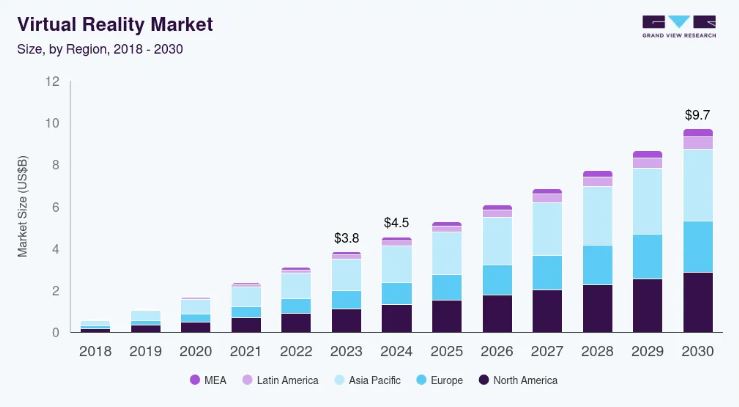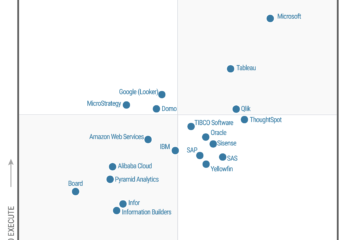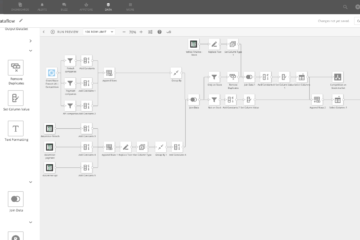The augmented reality (AR) and virtual reality (VR) market is undergoing rapid transformation in 2025. With a projected market size of $826.63 billion by 2032 and a CAGR of 39.1%, the AR/VR market is expanding beyond gaming into healthcare, education, engineering, and construction. This evolution presents both opportunities and challenges for businesses and developers alike.
AR/VR in 2025: Growth and Industries
Market Size and Projections
The global AR/VR market is booming, with revenue expected to reach $46.6 billion in 2025 and grow to $62 billion by 2029. The B2B segment, including healthcare, education, and engineering, is the fastest-growing area, driven by practical applications and enterprise adoption.

Healthcare: A Hub for VR/AR Innovation
In healthcare, AR and VR are revolutionizing medical training, surgical simulations, and remote diagnostics. The healthcare segment is expected to grow at a CAGR of 32.2%, as hospitals and medical institutions integrate immersive technologies into their workflows. Companies like HoloEyes are pioneering 3D anatomical visualizations for surgical planning, while startups such as Wundrsight are developing VR-based mental health solutions.
Education and Training: The Next Frontier
The education and corporate training sectors are also seeing significant growth, with the AR/VR training market projected to reach $82.92 billion by 2034. Virtual classrooms, AI-powered adaptive learning platforms, and interactive training simulations are becoming standard tools in educational institutions and corporate environments. These technologies enable faster skill acquisition, reduce training costs, and provide hands-on experience in a safe, controlled environment.
Engineering and Construction: Building the Future with VR/AR
In engineering and construction, AR and VR are being used for virtual prototyping, on-site assistance, and safety training. The construction market alone is expected to grow to $2.2 billion by 2025, as companies leverage immersive technologies to streamline design processes, improve collaboration, and enhance worker safety. Tools from companies like Autodesk and Unity are enabling engineers and architects to visualize complex projects and simulate real-world scenarios before breaking ground.
Gaming and Entertainment: Still a Dominant Force
While B2B applications are growing rapidly, gaming and entertainment remain the largest consumer segments for AR and VR. However, the gap between consumer and enterprise adoption is narrowing as industries recognize the value of immersive experiences for training, marketing, and customer engagement. Major players like Meta, Sony, and Valve continue to dominate the gaming space, but new entrants such as Pico and HTC are gaining traction, particularly in Asian markets.
Key Players and Competitive Dynamics
The AR/VR market is highly competitive, with both established tech giants and emerging startups vying for dominance. Understanding the strategies and strengths of these key players is essential for anyone looking to navigate this rapidly evolving landscape.
Meta (Facebook/Oculus): The Market Leader
Meta remains the dominant force in the AR/VR space, capturing approximately 70–75% of global headset shipments. The company’s Meta Quest 3 and Horizon OS have set industry standards, particularly in the consumer gaming segment. Meta’s strategy revolves around accessibility, affordability, and a robust ecosystem of apps and experiences, making it a formidable competitor in both B2C and B2B markets.
Apple: Redefining Premium Experiences
Apple’s entry into the AR/VR market with the Vision Pro has been a game-changer. By leveraging its proprietary M2 chip, Apple is challenging Qualcomm’s dominance and emphasizing premium experiences, privacy, and seamless integration with its existing ecosystem. The Vision Pro is positioned as a high-end device for both consumers and professionals, signalling Apple’s ambition to redefine how AR and VR are used in daily life.
Google and Samsung: Democratizing Mixed Reality
Google and Samsung are collaborating to democratize mixed reality through Android XR and the upcoming Project Moohan headset, expected to launch in late 2025. This partnership aims to create an open ecosystem that competes with Apple’s visionOS and Meta’s Horizon OS. By leveraging Qualcomm’s latest chips, Google and Samsung are positioning themselves to offer high-performance, affordable mixed reality experiences to a broader audience.

Sony, HTC, and Microsoft: Niche Leadership
While Meta and Apple dominate headlines, companies like Sony, HTC, and Microsoft continue to excel in niche markets. Sony’s PlayStation VR remains a leader in gaming, while HTC’s Vive and Microsoft’s HoloLens are widely used in enterprise and defense applications. Microsoft’s Integrated Visual Augmentation System (IVAS) for the U.S. Army is a prime example of how AR is being deployed in high-stakes environments.
Emerging Contenders: Varjo, DPVR, and XYZ Reality
Beyond the tech giants, several emerging players are making waves in the AR/VR space. Varjo, based in Finland, is known for its high-end VR and mixed reality headsets used in aerospace, defense, and healthcare. DPVR, headquartered in Belgium, is expanding its presence in enterprise VR, particularly in Asia. Meanwhile, XYZ Reality in the UK is pioneering AR solutions for construction and engineering, helping professionals visualize and interact with digital models in real-world environments.
The Battle of the Platforms: visionOS vs. Android XR vs. Horizon OS
Beyond hardware, the competition between Apple’s visionOS, Google’s Android XR, and Meta’s Horizon OS is shaping the future of the AR/VR ecosystem. Each platform offers unique advantages:
- visionOS is designed for seamless integration with Apple’s existing products, emphasizing privacy, security, and premium experiences.
- Android XR aims to create an open, flexible ecosystem that supports a wide range of devices and use cases, from gaming to enterprise applications.
- Horizon OS leverages Meta’s dominance in the consumer market, offering a robust library of apps and experiences tailored for both casual and professional users.
The outcome of this platform war will determine which companies can attract the most developers, create the most compelling content, and ultimately capture the largest share of the market.
Strategic Opportunities Across Industries
The rapid evolution of AR and VR is creating strategic opportunities across multiple industries. Companies that can effectively leverage these technologies stand to gain a competitive edge in their respective markets.
Healthcare: Enhancing Medical Training and Patient Care
In healthcare, AR and VR are being used to enhance medical training, improve surgical outcomes, and enable remote consultations. For example, virtual reality simulations allow medical students and surgeons to practice complex procedures in a risk-free environment, reducing the learning curve and improving patient safety. Additionally, AR-assisted diagnostics are helping clinicians visualize patient data in real time, leading to more accurate and efficient care.
Education and Training: Transforming Learning Experiences
The education sector is undergoing a transformation as AR and VR technologies make learning more interactive and engaging. Virtual classrooms, immersive history lessons, and hands-on technical training are just a few examples of how these technologies are being applied. Corporations are also adopting VR for employee training, particularly in high-risk industries like manufacturing and aviation, where simulation-based learning can significantly reduce accidents and improve performance.
Engineering and Construction: Streamlining Design and Collaboration
In engineering and construction, AR and VR are streamlining the design process, improving collaboration, and reducing costs. Architects and engineers can use virtual prototyping to visualize and test designs before construction begins, identifying potential issues early and avoiding costly revisions. On construction sites, AR-assisted tools provide workers with real-time guidance, enhancing safety and efficiency. Companies like Autodesk and Unity are at the forefront of this trend, offering powerful tools that integrate seamlessly with existing workflows.
Gaming and Entertainment: Pushing the Boundaries of Immersive Experiences
While the gaming and entertainment sectors have long been the primary drivers of AR and VR adoption, they continue to innovate. Game developers are creating increasingly immersive experiences, from hyper-realistic virtual worlds to social VR platforms that enable users to interact in shared digital spaces. Beyond gaming, VR is also being used for virtual concerts, interactive storytelling, and even virtual tourism, offering new ways for people to connect and explore.
If you need help in defining requirements for a Business Intelligence project or to review your existing architecture and identify gaps or opportunities, Rising Digits can help you.


